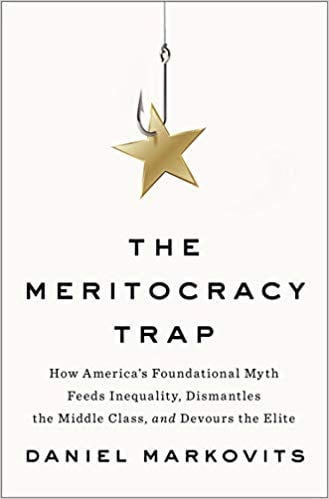You have /5 articles left.
Sign up for a free account or log in.
 The Meritocracy Trap: How America's Foundational Myth Feeds Inequality, Dismantles the Middle Class, and Devours the Elite by Daniel Markovits
The Meritocracy Trap: How America's Foundational Myth Feeds Inequality, Dismantles the Middle Class, and Devours the Elite by Daniel Markovits
Published in September of 2019.
One way to think of The Meritocracy Trap is as a master class developing a book-length argument. An alternative reading of the book would be one that highlights the dangers of making overly broad conclusions around too narrow a set of provocative ideas.
The willingness of Markovits, a Yale Law School professor, to draw sweeping conclusions from a set of narrow trends makes The Meritocracy Trap both a fascinating and frustrating read. Fascinating, as Markovits should make any participant in the world of elite education think about their place in creating and maintaining structural inequality. Frustrating, in that the book leaves out a broader range of competing trends and counter-arguments in building its case.
Markovits' overall argument is that the spread of meritocratic norms and practices have, on balance, caused a set of negative consequences for both the winners and losers of meritocracy.
By meritocratic norms and practices, Markovits is mostly referring to the arms race of enrichment, schooling, and credentials that characterize the experience of the children of today's professionals. The race to admittance to highly selective colleges begins with getting one's kid into the "right" preschool, and then continues after university graduation to attendance at top professional schools and offers of employment from elite firms.
This race to achieve high status and pay through intensive education and credentialing only serves, according to Markovits, to make everyone miserable. He traces the growing level of college student anxiety to the competitive pressures to excel, while reporting that the lives of elite workers (from highly paid lawyers to investment bankers) are objectively horrible.
The most elite and highly-paid worker secure their compensation not by exploiting others, but by exploiting themselves. Working 60 to 100 hours a week is the new normal among top-paid professionals, a pace of work that is making the highest-paid the most miserable.
The other losers of the meritocratic race, according to Markovits, are those in the broad middle class. Markovits defines this group as everyone who is not either very poor or very rich. They are citizens who went to college, but not to the most competitive and expensive schools. They work in jobs that are not highly super-specialized technology or professional roles. Unlike elite workers, the challenge of the middle class is not too much work - but too little. Wage stagnation, insecure employment, and the increasingly unsupportable level of housing and medical costs dominate this middle class.
Where I take issue with The Meritocracy Trap is that Markovits is so enamored with his argument against meritocracy that he fails to admit any evidence that might run counter to the narrative that he is selling.
For instance, Markovits insists on lumping the middle class together as anyone who is not rich and who is not poor. That is a very wide category.
In comparison, the number of super-highly paid investment bankers and lawyers and consultants are relatively tiny compared to the entire workforce. Professionals earning over $400,000 a year may be common in a few select superstar cities, but they are outliers in the broader labor market. Markovits has almost nothing to say about the experiences or prospects of the broad range of workers, preferring instead to have their story defined in relation to a numerically tiny elite.
Just as it would be a mistake to look for the real story of higher education by visiting very Ivy League campus, it is probably a mistake to understand the world of work by profiling a few top corporate lawyers or investment bankers. In reading The Meritocracy Trap, I kept wishing for Markovits to get out of New Haven, and visit the areas of the country that are experiencing the challenges and benefits of economic change.
The reality is that very few young professionals will ever end up working on Wall Street or in Silicon Valley. The action is in the South and the West, and in cities like Atlanta and Charlotte and Denver and Dallas and Houston and Phoenix. In these places, job growth is fast, and housing (at least compared to NYC or Boston or San Francisco) is still relatively affordable. The lives of professionals outside of the rarified air of top consulting companies and law firms may be challenging, but they are not being driven to meritocratic misery.
Nor did I find the ideas that Markovits advances to counter the ills of meritocracy all that convincing. Long-term trends towards economic inequality and wealth concentration will not be reversed by revoking the non-profit status of wealthy universities.
If Markovits is serious about leveling the playing field, a better set of recommendations would involve evening out funding for primary and secondary public schools (moving beyond funding by local property taxes), as well as making massive investments in public universities.
It would be a mistake to read this critique of The Meritocracy Trap as an argument against reading the book. The book is fantastic. Markovits makes a compelling, passionate, and data-driven set of arguments for the ills of meritocracy. Outstanding nonfiction books can be ones that drive you to think of all the reasons that the author is wrong. Not buying all of Markovits' arguments is different from admiring the skill in which they are presented.
This is a book that made me think about my role as both a product, and a cog, of the meritocratic machine.
What are you reading?








